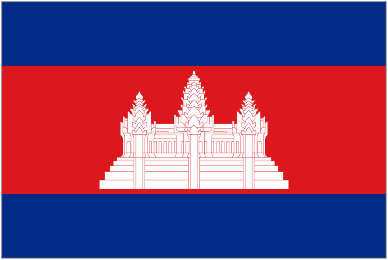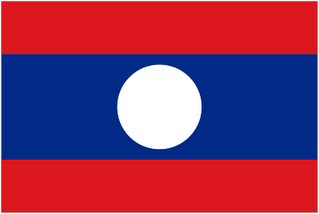Cambodia Info

King: Norodom Sihamoni (2004)
Prime Minister: Hun Sen (1998)

Land area: 68,154 sq mi (176,519 sq km)
Total area: 69,900 sq mi (181,040 sq km)
Population (2006 est.): 13,881,427 (growth rate: 1.8%)
Birth rate: 26.9/1000
Infant mortality rate: 68.8/1000
Life expectancy: 59.3
Density per sq mi: 204
Capital and largest city (2003 est.): Phnom Penh, 1,169,800
Monetary unit: Riel
Languages: Khmer 95% (official), French, English
Ethnicity/race: Khmer 90%, Vietnamese 5%, Chinese 1%, other 4%
Religions: Theravada Buddhist 95%, others 5%
Geography
Situated on the Indochinese peninsula, Cambodia is bordered by Thailand and Laos on the north and Vietnam on the east and south. The Gulf of Thailand is off the western coast. The size of Missouri, the country consists chiefly of a large alluvial plain ringed by mountains and on the east is the Mekong River. The plain is centered around Lake Tonle Sap, which is a natural storage basin of the Mekong.
Government
Multiparty liberal democracy under a constitutional monarchy.
History
The area that is present-day Cambodia came under Khmer rule about 600, when the region was at the center of a vast empire that stretched over most of Southeast Asia. Under the Khmers, who were Hindus, a magnificent temple complex was constructed at Angkor. Buddhism was introduced in the 12th century during the rule of Jayavaram VII. However, the kingdom, then known as Kambuja, fell into decline after Jayavaram's reign and was nearly annihilated by Thai and Vietnamese invaders. Its power steadily diminished until 1863, when France colonized the region, joining Cambodia, Laos, and Vietnam into a single protectorate known as French Indochina.
The French quickly usurped all but ceremonial powers from the monarch, Norodom. When he died in 1904, the French passed over his sons and handed the throne to his brother, Sisowath. Sisowath and his son ruled until 1941, when Norodom Sihanouk was elevated to power. Sihanouk's coronation, along with the Japanese occupation during the war, worked to reinforce a sentiment among Cambodians that the region should be free from outside control. After World War II, Cambodians sought independence, but France was reluctant to part with its colony. Cambodia was granted independence within the French Union in 1949. But the French-Indochinese War provided an opportunity for Sihanouk to gain full military control of the country. He abdicated in 1955 in favor of his parents, remaining head of the government, and when his father died in 1960, Sihanouk became chief of state without returning to the throne. In 1963, he sought a guarantee of Cambodia's neutrality from all parties in the Vietnam War.
However, North Vietnamese and Vietcong troops had begun using eastern Cambodia as a safe haven from which to launch attacks into South Vietnam, making it increasingly difficult to stay out of the war. An indigenous Communist guerrilla movement known as the Khmer Rouge also began to put pressure on the government in Phnom Penh.
On March 18, 1970, while Sihanouk was abroad, anti-Vietnamese riots broke out and Sihanouk was overthrown by Gen. Lon Nol. The Vietnam peace agreement of 1973 stipulated withdrawal of foreign forces from Cambodia, but fighting continued between Hanoi-backed insurgents and U.S.-supplied government troops.
Combat climaxed in April 1975 when the Lon Nol regime was overthrown by Pol Pot, leader of the Khmer Rouge forces. The four years of nightmarish Khmer Rouge rule led to the state-sponsored extermination of citizens by its own government. Between 1 million and 2 million people were massacred on the “killing fields” of Cambodia or worked to death through forced labor. Pol Pot's radical vision of transforming the country into a Marxist agrarian society led to the virtual extermination of the country's professional and technical classes.
Pol Pot was ousted by Vietnamese forces on Jan. 8, 1979, and a new pro-Hanoi government led by Heng Samrin was installed. Pol Pot and 35,000 Khmer Rouge fighters fled into the hills of western Cambodia, where they were joined by forces loyal to the ousted Sihanouk in a guerrilla movement aimed at overthrowing the Heng Samrin government. The Vietnamese plan originally called for a withdrawal by early 1990 and a negotiated political settlement. The talks became protracted, however, and a UN agreement was not signed until 1992, when Sihanouk was appointed leader of an interim Supreme National Council convened to run the country until elections could be held in 1993.
Free elections in May 1993 saw the defeat of Heng Samrin's successor, Hun Sen, who refused to accept the outcome of the vote. In early July, Hun Sen took advantage of the country's political turmoil to depose Prince Norodom Ranariddh. the country's only popularly elected leader. Hun Sen later launched a brutal purge, executing more than 40 political opponents. Shortly after the July coup, the Khmer Rouge organized a show trial of their notorious leader, Pol Pot, who had not been seen by the West in more than two decades. He was sentenced to house arrest for his crimes against humanity. He died on April 15, 1998. In the July 1998 election, Hun Sen defeated opposition leaders Sam Rainsy and Prince Ranariddh, but the opposition parties accused him of voter fraud. Cambodia was able to regain its UN seat, lost nearly a year earlier as a result of Hun Sen's coup.
Elections in July 2003 resulted in a stalemate—none of the parties won the two-thirds majority required to govern alone. Almost a year later, in June 2004, Ranariddh and Hun Sen agreed in June 2004 to form a coalition, with Hun Sen remaining prime minister. In August, Cambodia's parliament ratified the country's entry into the World Trade Organization.
In March 2003 the UN and Cambodia announced that after five years they had finally agreed on a system to try senior Khmer Rouge officials on charges of genocide. Among those who were expected to stand trial were Kang Kech Iev, alias Duch, who ran the notorious Tuol Sleng prison, and Ta Mok, alias The Butcher, who died in 2006 before his trial took place.
King Norodom Sihanouk announced in Oct. 2004 that he had abdicated and selected his son, Prince Norodom Sihamoni, to succeed him. Prince Sihamoni, a ballet dancer and choreographer, lived in France and had kept a distance from Cambodian politics.
In Feb. 2005, opposition leader Sam Rainsy was stripped of parliamentary immunity. He fled to France and was convicted in December in absentia of defaming Prime Minister Hun Sen. He received a royal pardon in 2006. Hun Sen has used defamation laws to crack down on political opponents and human rights groups, having at least seven activists and critics arrested in 2005 and 2006. Facing criticism from home and abroad, Hun Sen withdrew charges against four of the activists.




